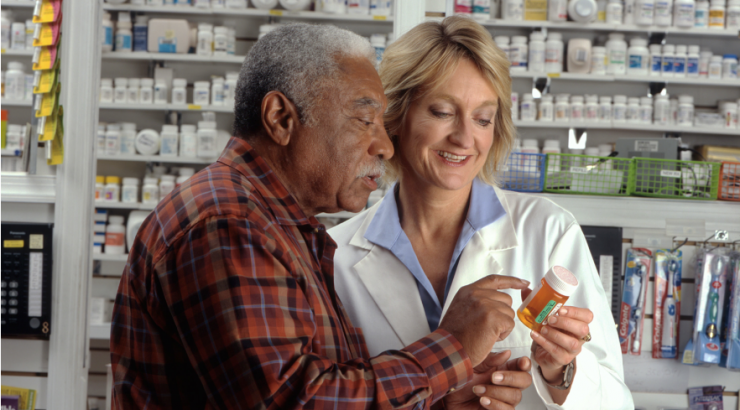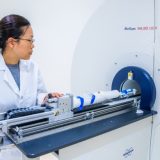
How to Become a Pharmacist: A Step-by-Step Guide Become a Pharmacist in 7 Steps
January 6, 2015
When you picture a pharmacist, you probably envision someone in a white lab coat behind the counter of your local pharmacy. While it’s true that this stereotype makes up a significant portion of the profession, it might surprise you to learn that many pharmacists work in hospitals, physician’s offices or outpatient care centers. In fact, the percentage of pharmacists employed in non-retail settings grew to more than 33% in 2023.
What does this mean for the future of the industry — and more importantly, how does it impact your path toward becoming a pharmacist? The good news is that pharmacy jobs will increase by 3% through 2032, so there’s ample opportunity for you to build your career.
In this guide, we’ll break down the steps you should take to become a pharmacist, including educational requirements, certifications and more.
Key Takeaways:
- You can start preparing for your pharmacy career as early as high school.
- Choose a traditional four-year undergraduate education or accelerate your path in a pre-pharmacy program.
- Consider opportunities to specialize your education as you work toward earning your master’s or Doctor of Pharmacy (Pharm.D.) degree.
- Building your career doesn’t have to be complicated. You can leverage your network and utilize job boards to reach success.
Steps Toward Becoming a Pharmacist and Building a Lasting Career in Healthcare
1. Start Preparing in High School
If you’re a high school student, you can prepare for your career while still in school by ensuring you take a comprehensive and balanced range of courses. That means enrolling in classes such as AP-level biology, chemistry, physics and mathematics. We also recommend participating in extracurricular activities to explore your interest in healthcare and science.
Don’t forget to discuss your career goals with your guidance counselor, who can help you make sure you’re on track for college.
2. Pursue an Undergraduate Education
As you search for colleges and prepare to enroll, be mindful of these three factors:
- Your major and minor: Choose a major that aligns with your desire to work in pharmacy. Biology or chemistry are great options as they build a solid foundation for the pharmaceutical sciences.
While your minor is less crucial in its ability to prepare you for a future as a pharmacist, consider selecting an area of study that complements your major and advances your knowledge.
- Maintaining your GPA and taking relevant courses: Stand out to pharmacy school admissions teams by maintaining a strong GPA, especially in classes related to your future graduate studies.
If you major in a STEM subject, your courses will naturally be relevant to the pharmaceutical sciences. If you’re not sure what to take, look for classes like organic chemistry, pharmacology and anatomy. Be aware that you must meet certain prerequisites to gain acceptance into a pharmacy program.
- Pre-pharmacy programs: Did you know there’s a way to begin pharmacy doctoral studies without an undergraduate degree? In Chapman University’s Accelerated Pre-Pharmacy Experience (APEx) program, you can earn your Doctor of Pharmacy degree in just five years. This option is a faster and more affordable pathway than the typical four-year college experience followed by two to three years in graduate school.
3. Determine Whether or Not You Want to Take the PCAT
While pharmacy schools no longer require the Pharmacy College Admission Test (PCAT), many high-ranking, competitive institutions, including Chapman University, recommend the test as a supplement to your application.
4. Attend Pharmacy School
After you’ve finished your bachelor’s degree, you can pursue pharmacy school — unless you’re in a pre-pharmacy program like Chapman’s, in which case, you’re a step ahead of the rest!
In general, a graduate pharmacy program takes four years to complete and provides hands-on experience through classroom instruction, lab work and clinical rotations. Some programs, such as the Master of Science in Pharmaceutical Sciences (MSPS), Doctor of Pharmacy (Pharm.D.) or Doctor of Philosophy in Pharmaceutical Sciences (Ph.D.) at Chapman, take only two years to complete.
Programs may offer specialties such as clinical pharmacy or research, so if you are interested in a particular specialty, evaluate your options carefully.
5. Explore Residency & Fellowship Opportunities
While most graduate-level pharmacy programs, including a Pharm.D., incorporate hands-on learning in their curriculum, a residency or fellowship may allow you to further deepen your knowledge in a real healthcare setting.
A residency or fellowship is not required to become a pharmacist. However, they do provide valuable post-graduate training that you might find helpful as you launch your career. Chapman University offers many residency and fellowship opportunities, including with prestigious institutions like Rutgers Institute and the University of Southern California.
6. Obtain Licensure
The North American Pharmacist Licensure Examination (NAPLEX) is a six-hour, 225-question standardized test that all prospective pharmacists must pass in order to acquire a pharmacy license in the United States. The exam fee is $620.
This test examines your ability to practice safely and effectively and covers topics including:
- Pharmacotherapy and therapeutic outcomes
- Safe and accurate preparation, compounding and dispensing of medications
- Public health and pharmacy practice
If you plan to practice in California, you must pass the California Practice Standards and Jurisprudence Examination for Pharmacists (CPJE). Otherwise, you must pass the Multistate Pharmacy Jurisprudence Examination (MPJE) or a state-sponsored exam, depending on the requirements of the respective state. Visit the California State Board of Pharmacy website for more information about CA-specific requirements to practice.
Remember — once you pass the NAPLEX, your education isn’t over. It’s important to stay up-to-date with changing trends and best practices so you can continue to provide the highest-quality care.
7. Build Your Career as a Pharmacist
As one of the very few healthcare experts with expertise touching every stage of the patient lifecycle, your role is vital. The pharmacy field offers a range of opportunities, from traditional community pharmacy jobs to specialized positions in hospitals, research and industry.
Here’s how you can get started and advance in this rewarding profession.
Job Search Tips
Landing the right job can be tricky. These tips will help you navigate the job market and hone your job search strategy.
- Leverage your network. Who you know is almost as important as what you know. While your knowledge and skills will get you far in your career, a strong professional network can take you farther.
For example, at Chapman University, our Alumni Association of 55,000 people root for the success of their peers. A support system like this can make a huge difference in your professional trajectory.
- Utilize job boards. These resources are a hub of opportunity to both find a job and connect with people in the industry — especially those who already hold a position you’re interested in pursuing. Try LinkedIn, ZipRecruiter or industry-specific boards like Pharmacistjobs.com.
- Stay curious. Pharmaceutical sciences are constantly evolving — from the creation of new drugs to changing regulations. As you start to find your footing, remain open to new opportunities and cultivate a curious mindset.
Common Questions
How long does it take to become a pharmacist?
It can take between five and eight years to become a pharmacist, depending on the program in which you enroll. For example, the Pre-Pharmacy program at Chapman University allows you to start your path toward becoming a pharmacist right out of high school, and it only takes five years to finish.
If you decide to pursue a traditional four-year undergraduate education, you can enroll in Chapman’s MS in Pharmaceutical Sciences or Pharm.D. program, both of which take only two years to complete, bringing your total time to completion to six years.
How much does it cost to become a pharmacist?
The cost of your education will vary greatly depending on the institution you attend and your financial situation, including whether or not you use scholarships, grants or student loans to cover the cost of tuition.
For example, Chapman School of Pharmacy programs are more affordable than other institutions because we offer merit scholarships each year. Incoming external students receive an award upon admission, and that can carry forward throughout their program as long as they maintain a 3.0 cumulative GPA and academic integrity and are in good standing.
We also have sponsored scholarships that come from organizations like Ralphs, Walgreens, Boiron, CVS and VPhA.
Chapman’s Accelerated Pre-Pharmacy students may receive a scholarship at our Orange campus during the first two years of their pre-pharmacy program and receive $44,000 toward the pharmacy program ($5,500 per term) as long as they successfully complete two years at Orange and meet the APEx’s minimum criteria.
What is the difference between a pharmacy tech and a pharmacist?
The key difference between a pharmacy tech and a pharmacist lies in their roles and responsibilities.
A pharmacy technician works under the direct supervision of a pharmacist and performs tasks such as labeling bottles, counting pills, managing inventory and handling customer service. In contrast, a pharmacist can (sometimes) prescribe medications, administer vaccinations and counsel patients on proper medication usage. They also provide clinical advice, perform medication reviews and check for drug interactions.
To learn more about what a pharmacist does, read our recent blog post about the roles of a pharmacist.
How much does a pharmacist make?
According to the Bureau of Labor Statistics, pharmacists earn a median annual salary of $136,030. Factors that may impact earning potential include location and industry, such as retail pharmacy, hospital pharmacy, etc.
Join Chapman School of Pharmacy’s Legacy of Excellence
Located in Irvine, California, the Chapman School of Pharmacy offers academic programs for students at every stage of their journey. Find the right program for you!
Our Pharmacy Programs
Accelerated Pre-Pharmacy Experience (APEx)
- Degree required for admission: high school diploma or GED
- Area of Focus: Pharmaceutical Sciences
- Time to Complete: Five years
- Degree Earned: Bachelor’s and master’s
Master of Science in Pharmaceutical Sciences (MSPS)
- Degree required for admission: Bachelor’s degree
- Area of Focus: Pharmaceutical Sciences
- Time to Complete: Two years
- Degree Earned: Master’s
Doctor of Pharmacy (Pharm.D.)
- Degree required for admission: Bachelor’s or master’s degree (valued, but not required)
- Area of Focus: Pharmaceutical Sciences
- Time to Complete: Two years
- Degree Earned: Doctorate
Doctor of Philosophy in Pharmaceutical Sciences (Ph.D.)
- Degree required for admission: Master’s degree
- Area of Focus: Pharmaceutical Sciences
- Time to Complete: Three to four years
- Degree Earned: Doctorate
Let Us Help You Navigate Your Career Path
Put your ambition into action at a School of Pharmacy dedicated to your success. Request more information about our programs, or contact us today to discover how Chapman can help you achieve your goals.

